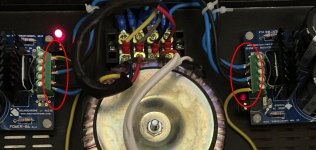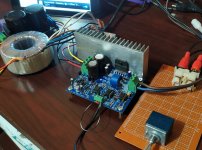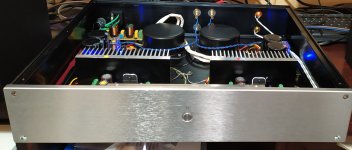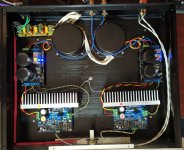Fantastic! Thank you for sharing your build experience.
I wouldn't worry too much about wire colours in a DIY project, but if someone is to service the amp at a later date, the yellow-green could throw them off. Then again, it's pretty obvious that it's not a safety ground.
More importantly, I suggest that you trim the wires going to the power supplies a bit. There's a lot of exposed copper sticking out, begging to be shorted together. Be careful when you trim those, though. The little wire strands tend to go into places where you really don't want a wire strand to go.
You could also drape them in a little heat shrink. That might be easier.
I'm glad you got the amp working though. Enjoy!
Tom
I wouldn't worry too much about wire colours in a DIY project, but if someone is to service the amp at a later date, the yellow-green could throw them off. Then again, it's pretty obvious that it's not a safety ground.
More importantly, I suggest that you trim the wires going to the power supplies a bit. There's a lot of exposed copper sticking out, begging to be shorted together. Be careful when you trim those, though. The little wire strands tend to go into places where you really don't want a wire strand to go.
You could also drape them in a little heat shrink. That might be easier.
I'm glad you got the amp working though. Enjoy!
Tom
Attachments
Thanks Tom, yes I uninsulated a little too much, these are stiff wires and I wanted to be sure the connector got a good mechanical purchase on the wires. Heatshrink it is.
Even using a tube preamp on my sensitive altecs I cannot hear that the amps are on from my listening seat.
Only slight hum when I play vinyl, but that is my boxless phonostages fault, need to fix that asap and lets not discuss wirecolors for that birds nest.
Even using a tube preamp on my sensitive altecs I cannot hear that the amps are on from my listening seat.
Only slight hum when I play vinyl, but that is my boxless phonostages fault, need to fix that asap and lets not discuss wirecolors for that birds nest.
Modulus-86 in progress!
Using separate 42v CT transformers for each channel. Just finished one channel. Right off the bat I had some hum issues because of my bad wiring of RCA into the balanced input. So far I spent a total of about 4 hours, and I still need to start working on the second channel. (this heat sink is a temporary arrangement.)
I recommend a 2x25 VAC transformer (or 25-0-25) for an LM3886-based amp optimized for 8 Ω. That'll give you about ±35-36 V rectified.
If you intend to drive both 8 Ω and 4 Ω speakers, I recommend a 2x22 VAC transformer. That'll give you around ±30 V rectified.
You can read more about why I make those recommendations here: Taming the LM3886 Chip Amplifier: Output Power – Neurochrome
With the Modulus-86, I do not see the point of using separate transformers for each channel. That said, there's no harm in it either. Well... Aside from the hit to the pocketbook, that is.
Tom
Using separate 42v CT transformers for each channel. Just finished one channel. Right off the bat I had some hum issues because of my bad wiring of RCA into the balanced input. So far I spent a total of about 4 hours, and I still need to start working on the second channel. (this heat sink is a temporary arrangement.)
Attachments
Question regarding switching power supplies: space I’ve read that the rectifier of the power supply should be placed as far away from the input of the amplifier as possible. Does this mean as far from the input on the chassis or the input on the modulus-86 itself?
Many thanks,
Kaden
Many thanks,
Kaden
Hum issue was because of wrong RCA to balanced wiring. After figuring that out I listened to a couple of albums last night and Modulus-86 makes very beautiful sound!Looks like a pretty beefy transformer and a nice and clean build overall. Excellent.
Did you get the hum issue figured out or would you still like some help with it?
Tom
I just finished soldering the second board and it took less than two hours! It is easy to build the second board since you already have a reference..
Question regarding switching power supplies: space I’ve read that the rectifier of the power supply should be placed as far away from the input of the amplifier as possible. Does this mean as far from the input on the chassis or the input on the modulus-86 itself?
Yeah... I'm the one spreading that rumour.
The rectifier in the SMPS - at least in the SMPS300RE (and -REh) - emits hum. It's probably because the conduction angle of the diodes (i.e., the part of the mains cycle where they're conducting) gets tiny under light load. This means that the current pulses charging the reservoir cap in the SMPS get substantial, which results in a large EM field around the rectifier and anything that connects to it. This EM field can couple into places where you don't want it, including the input of the amp.
In the first prototype of the Modulus-286 Kit (LE), now discontinued, I had the SMPS mounted such that its rectifier was practically right above the input to one of the amps. The rectifier was probably 25-30 mm away from the input connections. That channel showed significantly higher (probably 30 dB higher than the other channel AFAIR) mains hum. I think the hum was still below audible (at least with most speakers), but it degraded the SNR by ~30 dB and that doesn't really jibe with a $1250 kit. I drastically reduced the hum by rotating the SMPS 90º to get the rectifier away from the amp input.
Unfortunately, these large current pulses are a function of how rectifiers work, so you can't avoid them. No snubber will help with those.
So basically: Keep rectifiers and the wiring to them as far away from the inputs as you can. Keep in mind that the coupling of the EM fields decays by r2, so you don't need that much distance (r) to push the hum below the noise floor.
Tom
Last edited:
I was able to get the speaker return back to the board itself. Here is the first release of Modulus-86. I ran out of wires and ended up using whatever was available on hand. I might re-wire this after a couple of weeks or even change layout a little. But for now this is how it looks! Chassis turned out to be a little too big.
Transformers are 22-0-22V providing approx +/-30V rectified. Power drawn from the wall is just below 12W idle (both channels combined) and peaked at about 21W in my office room's loudest listening level. This could have been a weekend project if I had all components, chassis, heat sink etc readily available. Final layout design and wiring took a lot more time than just finishing the board and its individual testing.
Transformers are 22-0-22V providing approx +/-30V rectified. Power drawn from the wall is just below 12W idle (both channels combined) and peaked at about 21W in my office room's loudest listening level. This could have been a weekend project if I had all components, chassis, heat sink etc readily available. Final layout design and wiring took a lot more time than just finishing the board and its individual testing.
Attachments
Tom, I don’t see any vent holes in the bottom, so even with a ventilated top panel, I’d imagine convection would be inefficient at best; doesn’t a chimney need to draw in as much air as it exhausts? That’ll be harder to achieve if the chassis is essentially sealed on 5 sides.
As many operators of Intel based MacBooks or iMacs can probably attest, insufficient attention to thermal dissipation of total system operating at sustained high demand levels can be “problematic” at the least.
As many operators of Intel based MacBooks or iMacs can probably attest, insufficient attention to thermal dissipation of total system operating at sustained high demand levels can be “problematic” at the least.
The top panel has vent holes but not the bottom one! So essentially there cannot be much air circulation. I am considering a different chassis with heat sink on the sides and holes on top and bottom like I did with my MyRef-C.Nicely done! How do you ensure airflow across the heat sink fins? Do you have vent holes in the top and bottom panels?
A chassis that's a little bigger than needed is much preferred to one that's too small.
Tom
Tom, I don’t see any vent holes in the bottom, so even with a ventilated top panel, I’d imagine convection would be inefficient at best; doesn’t a chimney need to draw in as much air as it exhausts?
Ideally, yes. If you can make the air escape above the heat sink, it'll work better than no vent holes at all. But the best is to have unrestricted airflow parallel with the heat sink fins.
That said, the saving grace here is the rather large heat sinks. That allows much of the heat to conduct to the bottom panel wherefrom it can be conducted or radiate away.
I am considering a different chassis with heat sink on the sides and holes on top and bottom like I did with my MyRef-C.
I prefer those chassis. The one you have would make an excellent home for a preamp or headphone amp, though.
Tom
The SMPS-86 was discontinued because it didn't provide enough power to drive the Modulus-86 to clipping with a 4 Ω load. Also, with the Connex SMPS300REh and the Mean Well RPS-series there are better options on the market now.
The Mean Well Control will probably be discontinued. It only works with the RPS/RPP-300/400 series, so not with the 200-series. Also, the Mean Well supplies will power up as soon as they're plugged into the mains voltage, so they can be controlled by an ISS instead.
Hi Tom,
If you intend to discontinue the Mean well control board, will it be possible to create a split rail with two Meanwell units (RP300-27 specifically) by some other means? I've been wondering whether an ISS would be required for an SMPS supply - I think the answer is yes from what you have written. Will this enable the creation of a split rail supply without the Meanwell control board or is the ISS just bringing the low voltage switching control + obviously surge protection?
Connex don't seem to be very active in the UK as far as I can see (Audiophonics in France?), whereas Meanwell are available from all the usual suspects - Mouser/Farnell/RS etc - not that its a particular problem.
I've spent a long time drawing it out to get two Meanwell units safely and hopefully effectively into a smallish chassis so I feel committed now
My first post here; project delayed by this pesky virus but hopefully I can get started soon. Cheers, Dave
- Home
- Amplifiers
- Chip Amps
- Modulus-86 build thread



